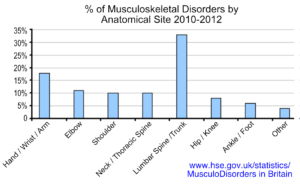Back pain is very common! But most of the time it is not serious and will settle down.
Key Facts
Four out of five adults (80%) will experience back pain at some stage in their life.
Nearly 50% of adults will experience back pain in any one year.
The most common age range for back pain in adults is between 35 to 55 years of age.
The British Chiropractic Association found that 12% of back and neck pain sufferers have put up with their problem for more than 10 years.
Most back pain, whilst painful, is not serious and will settle. The high numbers affected make it a very costly to individuals, employers and society.
Men and women are affected equally.
Simple measures can be taken to help prevent back pain.
Causes of back pain
85% of people cannot identify a clear cause for their back pain. The following factors could contribute to back pain:
- Sitting too long, recently called ‘the new smoking’
- Lack of exercise
- Previous back pain. Clients often say ‘I have a weak back’
- Smoking and obesity, which probably goes hand-in-hand with not enough movement and exercise.
- Heavy physical work, lifting, pulling and pushing or frequent bending and twisting
- Repetitive work and static postures, such as standing still all day, or bending and twisting over like a dentist
- Psychosocial factors such as stress, anxiety, depression, job satisfaction and mental stress.
Recovery from back pain
90% of acute back pain settles within 6 weeks, but up to 7% of people with acute back pain will develop chronic (long term) back pain. This swallows 80% of the social and health care costs.
The costs of back pain
The NHS in the UK spends more than £1 billion per year on back pain:
- £512 million on hospital costs
- £141 million on GP visits
- £150.6 million on physiotherapy treatment
£565 million a year is spent on private treatment for back pain.
This brings the healthcare costs for back pain to a total of £1.6 billion per year. In addition, UK employers lose between £590 and £624 million per year from back pain. This makes the cost of back pain between 1% and 2% of Gross National Product (GDP).
The impact of back pain on the individual
Back pain, in particular chronic, long-term back pain, can have a significant impact on people’s lives. It frequently reduces their quality of life and adversely affects their family and social relationships.
The impact of back pain on work and sick leave
- In 2003-04, nearly 5 million working days were lost due to back pain.
- On any one day, 1% of the working population are off work due to back pain.
- Back pain is the second main reason for long term sickness in the UK. In manual, physically intensive jobs, it is the number one reason.
Treatment of back pain
Nearly 40% of back pain sufferers consult GP for help, and 10% seek complementary treatment (osteopaths, chiropractors and acupuncturists).
Self help for back pain
It is very important to stay active with back pain – bed rest will only make the pain worse. Physical exercise helps reduce the pain and discomfort that long-term pain sufferers experience.
Chiropractic statistics
- According to the GCC (General Chiropractic Council) survey in 2016, Chiropractic is largely a private treatment, only 2% of Chiropractors work more than 25% for the NHS
- Lack of NHS funding is the main reason Chiropractic remains private.
Musculo-disorders by anatomical region 2013

The most common treatments by a Chiropractor are:
- Low back pain (28%)
- Knee pain (19%)
- Headache (16%)
- Neck pain (15%)
Low back pain statistics
- 1
It is the most common musculoskeletal disorder and the most common cause of disability under 45 years of age
- 2
It affects people of all ages
- 3
In 50% of cases, it will resolve within 2 weeks
- 4
In 80% of cases, it resolves within 6 weeks
- 5
20% of sufferers will develop chronic back pain, longer than 12 weeks
- 6
It is difficult to predict which cases will become chronic
- 7
90% of adults experience LBP sometime in their lives
- 8
It is the second or third leading reason for visits to GPs
- 9
It is the most frequent reason for visits to orthopaedic, spinal or neurosurgeons
- 10
The primary cause of work-related injuries
- 11
The most costly of all long-term disability and time-off-work conditions
- 12
It has a prevalence of 60-70% in industrialized countries
